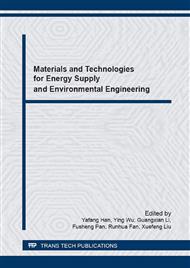p.460
p.466
p.472
p.479
p.485
p.490
p.497
p.505
p.510
Research and Application of Ultra-High Cementing Slurry
Abstract:
With the exploration of oil and gas in depth, shallow wells already can’t satisfy the requirement, therefore to explore and develop deep reservoirs is necessary. In the case of deep wells the loop temperature of bottom can reach to 150°C-200°C, which put forward a higher requirement for the high temperature resistance property of cement slurry. At present, many problems existed in the most of high temperature cement slurry. For example, high temperature resistance is not well, cement thickening time can’t adjust easily, mega-thermal sedimentation stability is unsatisfactory, and ultra-retarding phenomenon appeared for the top prone. After research indoors, we developed the ultra-high temperature slurry system by means of the investigation on cementing additives and select proper materials from high temperature resistant fluid loss additives, retarders, flowable agent at the same time. This system needs a lots of properties, such as, adjustable slurry thickening time below 200°C, great slurry sedimentation stability, API loss can be controlled at the range of 0-50ml, insensitive to temperature and density, could be used in low-density and conventional density cement etc. This system be used successfully in the well that loop temperature of bottom reaches to 185°C and get a good effect finally.
Info:
Periodical:
Pages:
485-489
Citation:
Online since:
March 2016
Authors:
Keywords:
Price:
Сopyright:
© 2016 Trans Tech Publications Ltd. All Rights Reserved
Share:
Citation:


